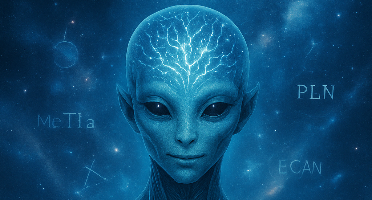Musonda Bemba
Project OwnerProject Lead
DEEP Connects Bold Ideas to Real World Change and build a better future together.
Coming Soon
HyperMind delivers a highly detailed & precise specification proposal to develop a modular, domain-general motivational system for Artificial General Intelligence (AGI), incorporating emotional modulation and ethical arbitration layers. The architecture is designed to support both human-aligned & alien motivational ontologies, with transparent mechanisms for goal decomposition, value-based tradeoffs, & ethical conflict resolution. The system integrates with symbolic (MeTTa, PLN), probabilistic (ECAN, DAS), & hybrid neural-symbolic agents, & is designed for scalable deployment in diverse environments including emotionally intelligent chatbots and virtual agents in the Sophiaverse.
Develop a modular and extensible framework for integrating various motivational systems into AGI architectures, supporting both human-like and "alien digital" intelligences. This could be done as a highly detailed and precise specification, or as a relatively simple software prototype with suggestions for generalization and extension. Bids are expected to range from $15,000 - $30,000.
Develop the foundational architecture of a modular AGI motivational framework capable of supporting both human-aligned and alien/digital-first ontologies. Embed ethical arbitration mechanisms to handle convergence/divergence in value systems. Technical Scope: Define a hierarchical motivational schema (overgoals subgoals metagoals antigoals). Embed PAD (Pleasure-Arousal-Dominance) emotional modulation hooks for future integration. Formalize dual motivational ontologies: Human-Aligned: Based on theories such as Maslow’s hierarchy and Self-Determination Theory. Digital-First: Grounded in Free-Energy Principle utility-maximization and novel value metrics. Introduce ethical interference arbitration logic: Constructive vs. destructive interference model for resolving ethical conflicts. Ethical wave-function representation enabling superpositional reasoning. Define abstract cross-domain agent interfaces (targeting MeTTa ECAN DAS and hybrid neural-symbolic systems). Build initial scaffolding for reinforcement learning policy hooks.
Specification Document Modular motivational hierarchy Ubergoal API definitions Arbitration logic Dual ontology schemas Simulation Prototype (Python + MeTTa) Testbed scenarios: Maslow-aligned vs. Free-Energy-based arbitration Integration Roadmap Compatibility planning with ECAN DAS Hyperon and neural-symbolic components GitHub Repository (v0.1) Interfaces ontology files arbitration logic stubs and example API implementation Literature Briefing PAD (OpenPsi) Self-Determination Theory Friston’s Free-Energy Principle ethical convergence models RL-based utility theory
$6,000 USD
AGI review board approves architectural specification and arbitration logic. Arbitration module resolves inter-ontology conflicts in ≥3 prototype simulations. Code demonstrates compatibility with ECAN/DAS/Hyperon architecture. Clearly defined modular structure with reusable abstractions for future layers.
Develop the emotional and ethical reasoning layers capable of handling dynamic goal prioritization and resolving moral tradeoffs under varied affective and cultural contexts. Technical Scope: Implement PAD-based modulation engine: Dynamic adjustment of goal saliency and urgency Threshold calibration for assertiveness vs. inhibition Ethical conflict resolution engine: Tradeoff calculus (e.g. fairness vs. efficiency) Conflict memory and persistence tracking Design fallback arbitration layers and deferral logic for unresolved ethical conflicts. Introduce mechanisms for cultural adaptability and temporal recalibration: Allow ethics modules to adapt based on environmental feedback or usage patterns.
PAD Emotional Modulation API updatePAD() applyPADModifiersToGoals() getEmotionalState() adjustInterferenceThresholds() Ethical Conflict Engine Utility-based moral reasoning Persistent disagreement logging Fallback arbitration mechanism Simulation Suite Multi-agent Sophiaverse-like dilemmas with conflicting moral imperatives Technical Documentation Cultural/temporal adaptation rationale Interference model diagrams and logic breakdown
$12,000 USD
≥85% resolution rate in ambiguous ethical dilemmas across blind-tested simulations Emotional modulation effectively shifts ethical behavior in line with PAD changes Human evaluators confirm contextual appropriateness and absence of pathological behaviors Cultural adaptability verified through recalibrated outcomes in differing ethical environments
Extend the motivational framework with feedback-aware ethical learning and ensure system readiness for real-world deployment and contribution to open AGI ecosystems. Technical Scope: Generalize motivational logic to include: Spatiotemporal tradeoffs (e.g. long-term vs. short-term gains) Nested tradeoff resolutions across multiple goal hierarchies Implement real-world feedback loop integration: Reinforcement-based reweighting of ethical goal preferences over time Outcome-driven evolution of ethics modules Package the complete system into a reproducible containerized module deployable via Docker. Merge contributions into upstream AGI projects (OpenPsi Hyperon) and release developer tooling.
Extended API Modules resolveTemporalTradeoff() adjustNestedGoalWeights() applyFeedbackToEthics() Deployment Kit Docker containers with full configurations Executable MeTTa and Python integration scripts Jupyter Notebooks Real-world feedback simulations Tuning protocols and benchmarking results GitHub PRs & CI/CD Integration Full testing documentation and peer-reviewed validation Tutorials & Case Studies Walkthroughs for AGI developers and research teams Use cases demonstrating real-world adaptation and ethical learning
$12,000 USD
System adopted by ≥2 external AGI projects (e.g., Sophiaverse, Unity, robotic agents) Ethical evolution loop exhibits measurable learning from simulated feedback All submitted PRs are peer-reviewed and merged with minimal revisions Tutorials and toolkits enable third-party reproducibility and contribution
Reviews & Ratings
Please create account or login to write a review and rate.
Check back later by refreshing the page.
© 2025 Deep Funding
Join the Discussion (0)
Please create account or login to post comments.